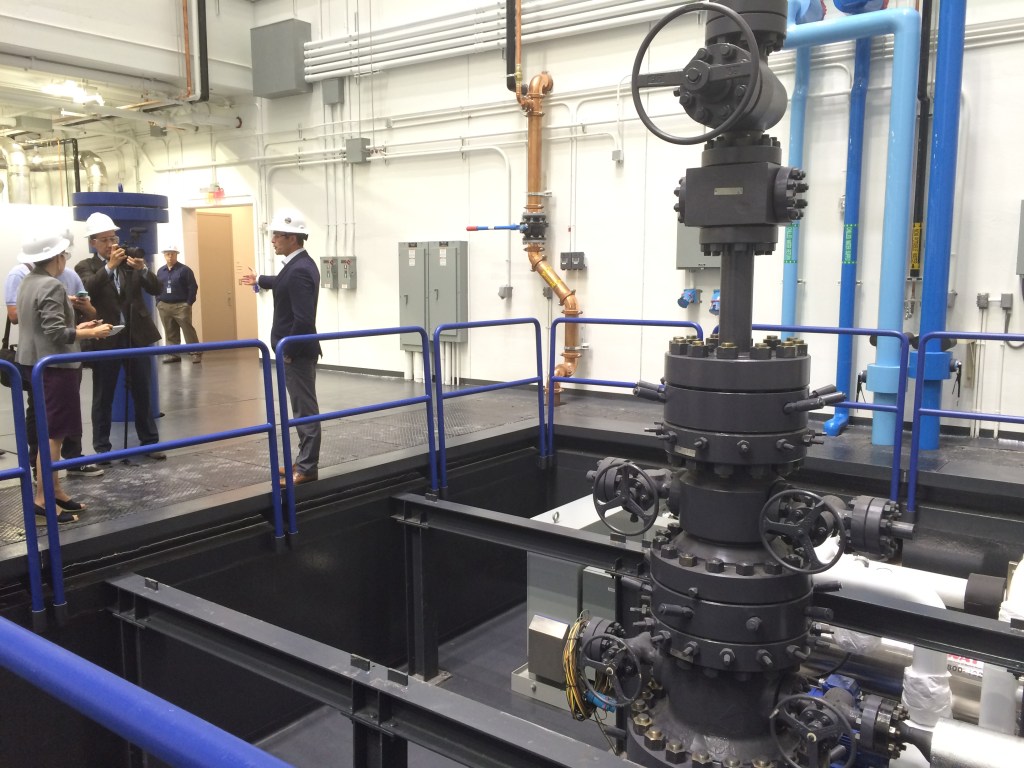GE’s Oklahoma lab aims to improve oil, gas operations
Published 7:15 am Friday, October 7, 2016

- Research engineer Matthew George shows visitors the 400-foot test well that was drilled into the floor of the GE Oil and Gas Technology Center in Oklahoma City. Engineers and scientists will be able to use the well, which does not have oil or gas in it, to test products before they're released to companies for trial.
OKLAHOMA CITY — Employees at General Electric’s new state-of-the-art Oil and Gas Technology Center in Oklahoma can’t help but admire the view.
Look out the windows and you can spot probably a dozen oil and gas companies just a stone’s throw away, said Jeremy Van Dam, a project manager at the five-story, 125,000-square-foot office and laboratory.
Eating in the cafeteria, employees have a clear view of the state Capitol. It’s just down the street from their facility off Interstate 35, which is also just a few blocks from the University of Oklahoma Medical Center.
“We’re really in the heartland of new development,” Van Dam said.
This week, state, community and business leaders celebrated the long-awaited opening of the one-of-a-kind facility that GE contends will help revolutionize oil and gas development.
“On a macro basis, the oil and gas industry is here to stay,” said Lorenzo Simonelli, president and CEO of GE’s oil and gas division. “We look at this as being a long-term game.”
Scientists and engineers will spend their days developing new technologies that they say will ultimately make the industry more efficient.
Van Dam, for instance, showed off a prototype of a jet pump design that has the potential to change how oil is extracted from the ground with the use of existing salt water.
The lab is equipped with wells — 400- and 60-feet deep — where designs can be tested before they’re sent to the oil fields.
Upstairs, though, is the home of the pride of the center — a drone named Raven, developed in conjunction with Oklahoma State University. It can be controlled and monitored from Oklahoma City while it flies as far away as an airfield in Stillwater.
The drone, rigged with methane sensors, video transmitters and GPS, can help detect methane leaks that pollute the environment and cost companies money.
Developers say the prototype, which is the size of a small box, has already been successfully tested in Arkansas. It is not yet for sale.
The research center, which currently employs 120 scientists and engineers, is the 10th such center that GE has opened since the company was started in 1892 by Thomas Edison. Other centers, focused on other industries, are located all over the world including in China, India and Brazil.
Oklahoma beat out a group of international contenders to land the center, which Gov. Mary Fallin hailed as a “really big deal” and “a very exciting adventure.”
Its proximity to the state’s two largest research colleges — the University of Oklahoma and OSU — attracted the company, said Jason Angolano, laboratory operations manager.
So did the more unconventional drilling methods being used on the shales here, he said.
“That is the new oil field,” he said of Oklahoma drillers’ methods.
While GE officials are closed mouthed about other projects in development, Angolano said the center is actively working with OU and OSU.
He noted some employees are researching the induced seismicity blamed in part for the state’s recent rise in earthquakes, as well as water challenges.
Vic Abate, GE’s chief technology officer, said the company makes “multi-billion-dollar bets” on the future of technology, and to believes oil and gas production “is vital” to the world and will remain so for years to come.
The company is counting on the state’s universities to continue to produce talented scientists and engineers, who hopefully will consider coming to work at the facility in the future, he said.
“This about the future of oil and gas and the future of energy for Oklahoma,” he told an invitation-only crowd who got a look inside the facility, which is guarded by gates and security.
GE predicts that by 2035, the world will need to invest $38 trillion in infrastructure to meet energy demand. Already, the oil and gas industry has 129,000 pieces of equipment in operation worldwide.
By 2025, the company predicts gas consumption will be up by 36 percent, and it believes global shale production has the potential to reach as high as 14 million barrels of oil per day ten years after that.
Employees, though, say they’re just looking forward to getting started in their new lab.
“It’s been wonderful to bring in a lot of great talent to the state,” Angolano said. “You get a good sense of pride when you mention where you’re working.”
Janelle Stecklein covers the Oklahoma Statehouse for CNHI’s newspapers and websites. Reach her at jstecklein@cnhi.com.





